West Bengal Tourism
About Jaldapara National Park
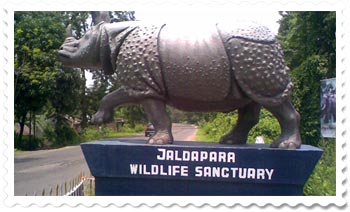 Jaldapara National Park was formerly known as the Jaldapara Wildlife Sanctuary. It was declared a sanctuary in 1941 for protection of the great variety of flora and fauna and was declared as a national park in May 2012. Jaldapara National Park is located in the flood plains of river Torsha. It lies at Madarihat Block in Jalpaiguri district. The total area is nearly over 200 square kilometer. The entry point is from Madarihat, close to national highway number 31 in between Hashimara and Birpara about 55 kilometers away from Alipurduar. The nearest railway station is Falakata nearly 22 kilometer from Madarihat. Although Jaldapara is famed for its majestic one horned rhinos, the forest provides a safe sanctuary for the host of other equally impressive and for some people who explore the park on feet, deadly stock of animals. Some of them are elephant, gaur (Indian bison), wild boar and leopards. Other less dangerous creatures are chital, sambhar, barasingha, the hog deer, barking deer and other. Jaldapara National Park is exceptionally rich in avifauna because of varied terrain, mosaic of vegetation and rich insect life. More than 240 species of birds are found here and some of them are Green Pigeons, Barbets, Parakeets, Woodpeckers, Cuckoos, Orioles, Drongos, Babblers, and Thrushes etc. Hollong Forest Resort, inside the park or Government Tourist Lodge at Madarihat about four km from the park are the best accommodation found here. You can also find a number of private resorts available at Madarihat for accommodation.
Jaldapara National Park was formerly known as the Jaldapara Wildlife Sanctuary. It was declared a sanctuary in 1941 for protection of the great variety of flora and fauna and was declared as a national park in May 2012. Jaldapara National Park is located in the flood plains of river Torsha. It lies at Madarihat Block in Jalpaiguri district. The total area is nearly over 200 square kilometer. The entry point is from Madarihat, close to national highway number 31 in between Hashimara and Birpara about 55 kilometers away from Alipurduar. The nearest railway station is Falakata nearly 22 kilometer from Madarihat. Although Jaldapara is famed for its majestic one horned rhinos, the forest provides a safe sanctuary for the host of other equally impressive and for some people who explore the park on feet, deadly stock of animals. Some of them are elephant, gaur (Indian bison), wild boar and leopards. Other less dangerous creatures are chital, sambhar, barasingha, the hog deer, barking deer and other. Jaldapara National Park is exceptionally rich in avifauna because of varied terrain, mosaic of vegetation and rich insect life. More than 240 species of birds are found here and some of them are Green Pigeons, Barbets, Parakeets, Woodpeckers, Cuckoos, Orioles, Drongos, Babblers, and Thrushes etc. Hollong Forest Resort, inside the park or Government Tourist Lodge at Madarihat about four km from the park are the best accommodation found here. You can also find a number of private resorts available at Madarihat for accommodation.
Places to visit in Jaldapara National Park
-
Elephant Safari at Jaldapara National Park
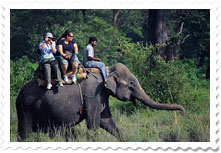 The major attraction of Jaldapara National Park is the Elephant Safari. Scope for elephant safari in Jaldpara Wildlife Sanctuary is really very limited but if you love wild life and passionate about jungles, elephant safari is a must do thing when you are in Jaldpara forest. The scope of spotting wild animals is much better in elephant safari compared to jeep safari and it is really a thrilling & adventurous way to feel the fun of jungles. An elephant takes you deep inside the forest where a jeep or vehicle won,t be able to take you. The elephant passes through the dense woods, crosses the water streams, and takes you close to a one horned Rhino or a Bison. It is an awesome feeling and sight when you see a leopard at a few meters distance or a Chital feeding her baby. Elephant safari is the best way to explore the sanctuary. The safari begins early in the morning and should be booked early; its availability in high season cannot be guaranteed. Safari starts from the Tourist Lodge at Madarihat and the maximum number of people allowed for this safari is four.
The major attraction of Jaldapara National Park is the Elephant Safari. Scope for elephant safari in Jaldpara Wildlife Sanctuary is really very limited but if you love wild life and passionate about jungles, elephant safari is a must do thing when you are in Jaldpara forest. The scope of spotting wild animals is much better in elephant safari compared to jeep safari and it is really a thrilling & adventurous way to feel the fun of jungles. An elephant takes you deep inside the forest where a jeep or vehicle won,t be able to take you. The elephant passes through the dense woods, crosses the water streams, and takes you close to a one horned Rhino or a Bison. It is an awesome feeling and sight when you see a leopard at a few meters distance or a Chital feeding her baby. Elephant safari is the best way to explore the sanctuary. The safari begins early in the morning and should be booked early; its availability in high season cannot be guaranteed. Safari starts from the Tourist Lodge at Madarihat and the maximum number of people allowed for this safari is four. -
Jeep Safari at Jaldapara National Park
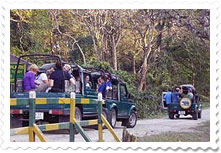 The Jeep Safari inside the Jaldapara Sanctuary is another main attraction. Jeep safari is another way to explore the wild. Jeep safari can be done from Madarihat Jaldapara Tourist Lodge and Kodalbasti Point on way to Chilapata range. The forest department does not provide jeep safaris so one has to rent from the Tourist Lodge at Madarihat or a tourist agency. A forest guard must accompany the jeep. The sights of rhino in a muddy pond, the herd of elephants or the running deer are the thrilling experiences in Jaldapara National Park. Jaldapara is also known as a paradise for bird watchers. One can witness The Indian Roller (Coracias benghalensis), the extremely rare Himalayan Vulture, a few species of the Kingfisher birds, etc. Unlike Elephant Safari which is only available in morning Jeep Safari is available both in the morning and afternoon. Jeeps are allowed inside the park from 6-8AM & 3-5PM.
The Jeep Safari inside the Jaldapara Sanctuary is another main attraction. Jeep safari is another way to explore the wild. Jeep safari can be done from Madarihat Jaldapara Tourist Lodge and Kodalbasti Point on way to Chilapata range. The forest department does not provide jeep safaris so one has to rent from the Tourist Lodge at Madarihat or a tourist agency. A forest guard must accompany the jeep. The sights of rhino in a muddy pond, the herd of elephants or the running deer are the thrilling experiences in Jaldapara National Park. Jaldapara is also known as a paradise for bird watchers. One can witness The Indian Roller (Coracias benghalensis), the extremely rare Himalayan Vulture, a few species of the Kingfisher birds, etc. Unlike Elephant Safari which is only available in morning Jeep Safari is available both in the morning and afternoon. Jeeps are allowed inside the park from 6-8AM & 3-5PM.
Sikiajhora
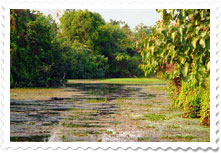 Sikiajhora is situated in North Panialguri of Alipurduar subdivision. Sikiajhora is a small stream that flows within the Buxa Tiger reserve. A small dam and embankment was constructed by forest department here a few years back. There was also boating trip available inside the forest. The small stream turned a furious river during the rainy season and the embankments were breached. There is an eco tourism development committee comprising local villagers. They take care of the picnickers. Kalkut a forest village is a picnic spot to lure tourists is on the other side of the road. Number of birds visits the area every year. There is a watch Tower for bird watching. If you are here to be close to nature, you would still love spending a couple of hours besides the forest on the watchtower.
Sikiajhora is situated in North Panialguri of Alipurduar subdivision. Sikiajhora is a small stream that flows within the Buxa Tiger reserve. A small dam and embankment was constructed by forest department here a few years back. There was also boating trip available inside the forest. The small stream turned a furious river during the rainy season and the embankments were breached. There is an eco tourism development committee comprising local villagers. They take care of the picnickers. Kalkut a forest village is a picnic spot to lure tourists is on the other side of the road. Number of birds visits the area every year. There is a watch Tower for bird watching. If you are here to be close to nature, you would still love spending a couple of hours besides the forest on the watchtower.
South Khayerbari Leopard Rescue Centre
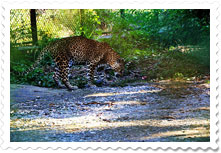 South Khayerbari Leopard Rescue Centre also known as Khayerbari Nature Park is just 10 km away from Madarihat and 15 km away from Jaldapara. It is a tiger rescue centre. A number of Royal Bengal Tigers & leopards have been brought to the centre after the ban of these animals in various circuses. Here the visitors get an opportunity to have a closer view of these animals from. The park has been developed with the objective of treatment and rehabilitation of leopards and tigers. The leopards and tigers have been kept in a natural environment in this park. Battery operated cars are used to conduct safari tours in this nature park. River Buri Torsa is flowing through the South Khayerbari Nature Park. Boating can be done in the waters of the river.
South Khayerbari Leopard Rescue Centre also known as Khayerbari Nature Park is just 10 km away from Madarihat and 15 km away from Jaldapara. It is a tiger rescue centre. A number of Royal Bengal Tigers & leopards have been brought to the centre after the ban of these animals in various circuses. Here the visitors get an opportunity to have a closer view of these animals from. The park has been developed with the objective of treatment and rehabilitation of leopards and tigers. The leopards and tigers have been kept in a natural environment in this park. Battery operated cars are used to conduct safari tours in this nature park. River Buri Torsa is flowing through the South Khayerbari Nature Park. Boating can be done in the waters of the river.
Kunjanagar Eco Park
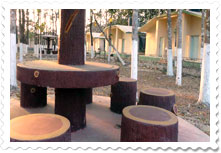 Kunjanagar Eco Park is situated in Jalpaiguri District of West Bengal in India and is 10 km from Falakata. The place is surrounded by rich forests and corn fields. There is a suspension bridge. On one side of the bridge is Kunjanagar and on the other side is Jaldapara Wildlife Sanctuary. River Torsa is flowing in the middle of Kunjanagar and Jaldapara. A watch tower is there for seeing wild animals. The view from the tower is awe inspiring. The popularity of Kunjanagar for boating is increasing rapidly in the recent years. Here you can see leopard, deer, gharial and rose-ringed parakeet. If luck favours, you may see rhino, deer or elephant during boating. Wild animals are not found always, but sitting on the Watch Tower you will feel nature as your own. There is arrangement for picnic. So day time remains lively. The evenings are beautiful.
Kunjanagar Eco Park is situated in Jalpaiguri District of West Bengal in India and is 10 km from Falakata. The place is surrounded by rich forests and corn fields. There is a suspension bridge. On one side of the bridge is Kunjanagar and on the other side is Jaldapara Wildlife Sanctuary. River Torsa is flowing in the middle of Kunjanagar and Jaldapara. A watch tower is there for seeing wild animals. The view from the tower is awe inspiring. The popularity of Kunjanagar for boating is increasing rapidly in the recent years. Here you can see leopard, deer, gharial and rose-ringed parakeet. If luck favours, you may see rhino, deer or elephant during boating. Wild animals are not found always, but sitting on the Watch Tower you will feel nature as your own. There is arrangement for picnic. So day time remains lively. The evenings are beautiful.
Chilapata Jungle Safari
 Chilapata Jungle Safari will take you to the dense natural forest near Jaldapara National Park in Dooars. As you drive inside Chilapata you can immediately sense jungle getting close. A drive through the forests is an interesting experience. Sighting of elephants are almost regular in a Jungle Safari. River Torsha runs through the sanctuary. The forest is mainly savannah covered with tall elephant grasses. The wildlife, in addition to one-horned Rhinos, consists of wild Elephants, Deer, Sambhar, Barking Deer, Spotted Deer and Hog Deer, wild Pig, Gour and a number of Birds, Peafowls. The Chilapata Jungle Safari would take you inside the forest and wild life sighting is most common. The CC Line watch tower is located close to Torsa river bed. The wide river bed offers view of a stretch of several kms and sighting of Gaur (Indian Bison), Elephant and Rhino are common from here apart from smaller animals such as Deers, Birds of wide variety and others. The guided safaris can take you to the Kodalbasti forest and the Mendabari watch tower.
Chilapata Jungle Safari will take you to the dense natural forest near Jaldapara National Park in Dooars. As you drive inside Chilapata you can immediately sense jungle getting close. A drive through the forests is an interesting experience. Sighting of elephants are almost regular in a Jungle Safari. River Torsha runs through the sanctuary. The forest is mainly savannah covered with tall elephant grasses. The wildlife, in addition to one-horned Rhinos, consists of wild Elephants, Deer, Sambhar, Barking Deer, Spotted Deer and Hog Deer, wild Pig, Gour and a number of Birds, Peafowls. The Chilapata Jungle Safari would take you inside the forest and wild life sighting is most common. The CC Line watch tower is located close to Torsa river bed. The wide river bed offers view of a stretch of several kms and sighting of Gaur (Indian Bison), Elephant and Rhino are common from here apart from smaller animals such as Deers, Birds of wide variety and others. The guided safaris can take you to the Kodalbasti forest and the Mendabari watch tower.
Riverine Safari at Totopara
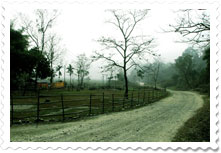 Toto Para is a small village on the lap of Himalayan range situated at the border of India and Bhutan, under Madarihat - Birpara Block. This picturesque village is the abode of Primitive Tribal Group, Toto. Presently there are 1564 Totos in Toto Para. Totopara is 147 km from Siliguri (via NH31C), 22 km from Jaldapara and 65 kms from Alipurduar. A riverine jeep safari in TotoPara with Mt Kanchenjunga in the backdrop is a great experience for any Indian Roadie.
Toto Para is a small village on the lap of Himalayan range situated at the border of India and Bhutan, under Madarihat - Birpara Block. This picturesque village is the abode of Primitive Tribal Group, Toto. Presently there are 1564 Totos in Toto Para. Totopara is 147 km from Siliguri (via NH31C), 22 km from Jaldapara and 65 kms from Alipurduar. A riverine jeep safari in TotoPara with Mt Kanchenjunga in the backdrop is a great experience for any Indian Roadie.

